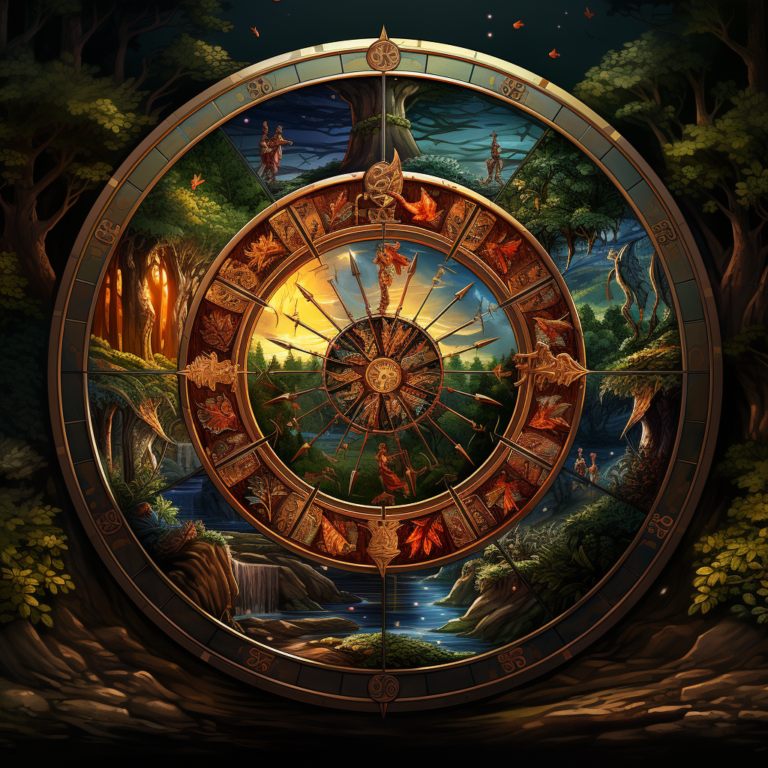Pagan Holidays 2023 The Wheel of the Year
Paganism, with its roots stretching back to ancient times, is a belief system that embraces a deep reverence for nature and the cycles of the seasons. It provides a spiritual framework that honors the interconnectedness of all living things and seeks to harmonize with the natural world.
Central to Paganism is the Wheel of the Year, a sacred calendar that guides practitioners through the ebb and flow of the seasons and the corresponding holidays known as sabbats.
The Wheel of the Year serves as a profound symbol of the eternal cycles of birth, growth, death, and rebirth. It mirrors the rhythmic dance of the sun, the moon, and the earth, reminding us that life itself is a continuous journey of transformation.
As the wheel turns, each holiday within it holds its unique significance and purpose, inviting individuals to connect with the changing energies of the natural world and celebrate the mysteries of existence.
In the modern world, where technology and urban landscapes often disconnect us from nature’s rhythms, Pagan holidays offer a way to rekindle our primal connection to the earth. They provide an opportunity to pause, reflect, and immerse ourselves in the wisdom of the natural cycles that shape our lives.
Through these celebrations, Paganism encourages individuals to step outside the confines of societal norms and reconnect with the primal forces that sustain us.
By embracing Pagan holidays, individuals can find solace in the beauty of the changing seasons, gain a deeper understanding of their place in the universe, and cultivate a sense of gratitude for the abundant gifts of the earth.
These celebrations invite us to slow down, attune ourselves to the subtle shifts in nature, and engage in rituals and practices that help us align with the energies of the moment.
In the following sections of this blog post, we will explore the significance and traditions associated with each of the eight major Pagan holidays in the Wheel of the Year. From the ancestral reverence of Samhain to the joyous festivities of Beltane, we will delve into the rich tapestry of rituals, symbols, and customs that have been passed down through generations.
By delving into these Pagan holidays, we embark on a journey of discovery, opening ourselves to the wisdom and magic that lies within the ancient traditions of Paganism.
So, let us embark on this enchanting exploration of the Wheel of the Year and immerse ourselves in the wonders of Pagan holidays, as we honor the sacred cycles of nature and embrace the timeless connection between humanity and the earth.
The Wheel of the Year
The Wheel of the Year is a profound symbol and framework that guides Pagan practitioners through the cyclical nature of life and the changing seasons. It represents the eternal dance of birth, growth, death, and rebirth that occurs in both the natural world and within ourselves. This sacred calendar consists of eight major Pagan holidays, known as sabbats, which are spaced throughout the year, marking significant points in the solar and agricultural cycles.
Aligned with the solstices, equinoxes, and the cross-quarter days, each of the pagan holidays within the Wheel of the Year holds its unique symbolism and purpose. The sabbats are not only an opportunity to celebrate and connect with the rhythms of nature but also to honor the spiritual and mythological aspects associated with each festival.
By observing these Pagan holidays, practitioners seek to reconnect with the natural world and honor its rhythms.
Samhain
The Witches’ New Year Samhain, (pronounced Sow-Ween)celebrated on October 31st, is considered the most important and magical of the Pagan holidays. It marks the end of the harvest season and the beginning of winter.
Its roots can be traced back to ancient Celtic traditions and it holds significant spiritual and historical significance.
Samhain is a time when the veil between the physical world and the spirit realm is believed to be at its thinnest. It is a liminal space where the living and the departed can come together, facilitating communication with ancestors and spirits.
Pagans view this as an opportunity to honor and connect with their ancestors, seeking their guidance and wisdom.
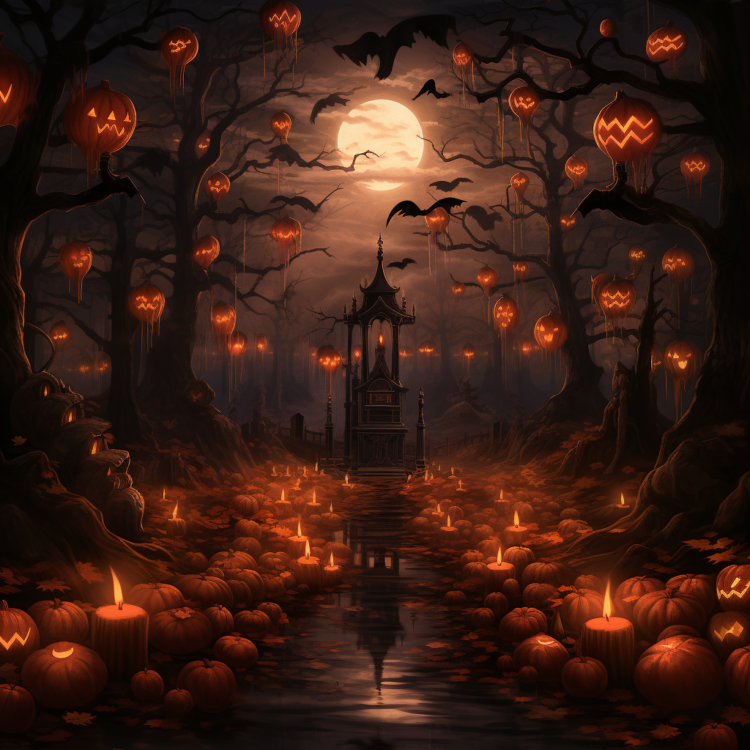
One of the central themes of Samhain is remembrance. Pagans take this time to reflect on the cycle of life and death, acknowledging the impermanence of existence. It is a moment to honor and pay tribute to those who have passed away, recognizing their impact on our lives and the legacy they leave behind.
Altars are adorned with photographs, mementos, and items of significance to remember and honor loved ones.
Samhain is also a time for divination and introspection. The thinning of the veil is believed to enhance one’s ability to receive messages from the spirit world and gain insights into the future. Practices such as tarot readings, scrying, and mediumship are commonly employed during this time to seek guidance and spiritual clarity.
Bonfires play a significant role in Samhain celebrations. The warm glow of the flames not only provides physical warmth but is also believed to serve as a beacon to guide and welcome the spirits.
It is customary to gather around the bonfire, sharing stories, singing songs, and engaging in communal rituals that strengthen the bond between the living and the deceased.
Another aspect of Samhain is the concept of releasing and letting go. As nature undergoes a process of shedding and preparing for winter, Pagans embrace this energy of release in their personal lives. It is a time to reflect on what no longer serves them, to release old patterns and baggage, and to make space for new beginnings.
Costumes and masks are often worn during Samhain, serving multiple purposes. They can be used as a form of protection, to disguise oneself from malevolent spirits, or to honor the thinning of the veil by embodying archetypal figures or mythical beings. This tradition is believed to have clearly influenced the modern-day practice of Halloween costumes.
In modern Pagan holidays celebrations, Samhain is observed in various ways, depending on individual beliefs and traditions. Rituals may involve creating and sharing a feast, conducting ancestor rituals, lighting candles to guide the spirits, and participating in activities that honor the cycle of life and death.
Samhain holds a deep spiritual significance for Pagans, providing an opportunity to honor the past, seek guidance from ancestors, and embrace the mysteries of life and death. It is a time of remembrance, divination, and introspection—a powerful and transformative holiday that reminds us of the interconnectedness of all things and the eternal cycle of existence.
Yule
The Winter Solstice Yule, celebrated around December 21st, is a joyous and one of the most significant of the Pagan holidays within the Wheel of the Year. It marks the winter solstice, the shortest day and longest night of the year, and holds profound symbolism related to the rebirth of the sun and the return of light.
Yule is one of our favorite Pagan holidays and a time of celebration and hope, as it signifies the turning point in the year when the days begin to grow longer again. It represents the triumph of light over darkness, and Pagans embrace this symbolism by kindling fires, lighting candles, and adorning their homes with evergreens to symbolize the continuity of life even in the midst of winter’s chill.
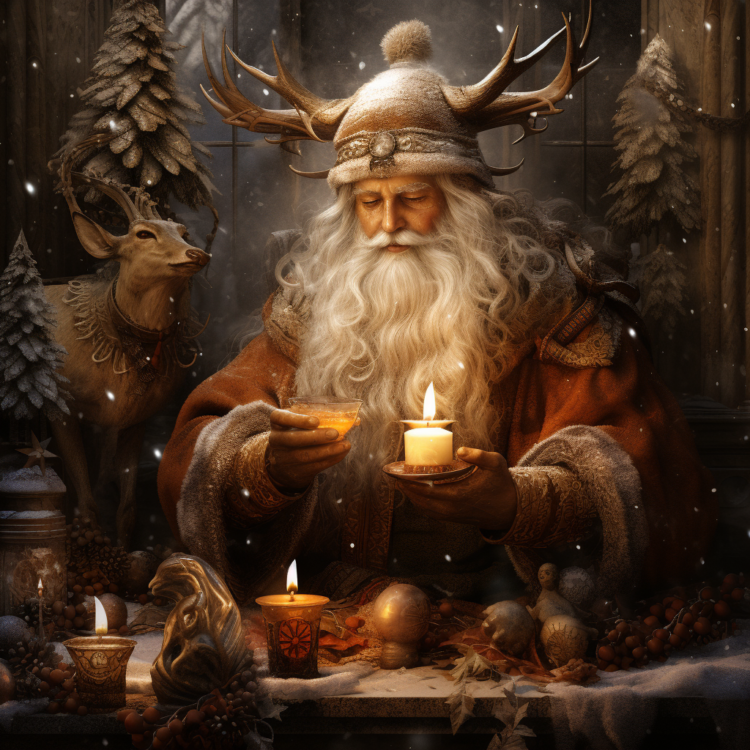
One of the central themes of Yule is the rebirth of the sun. Pagans view this holiday as a time of renewal, both in the natural world and within themselves. It is a time to reflect on the past year, release what no longer serves, and set intentions for the coming year. Yule rituals often involve meditation, introspection, and creating space for personal growth and transformation.
Yule logs hold a prominent place in Yule celebrations. Traditionally, a large log, often oak or ash, is selected and ceremonially burned in the hearth or bonfire. The log is decorated with evergreens, ribbons, and symbols of luck and prosperity. As it burns, the log provides warmth and light, symbolizing the returning energy of the sun and the life-giving properties of fire.
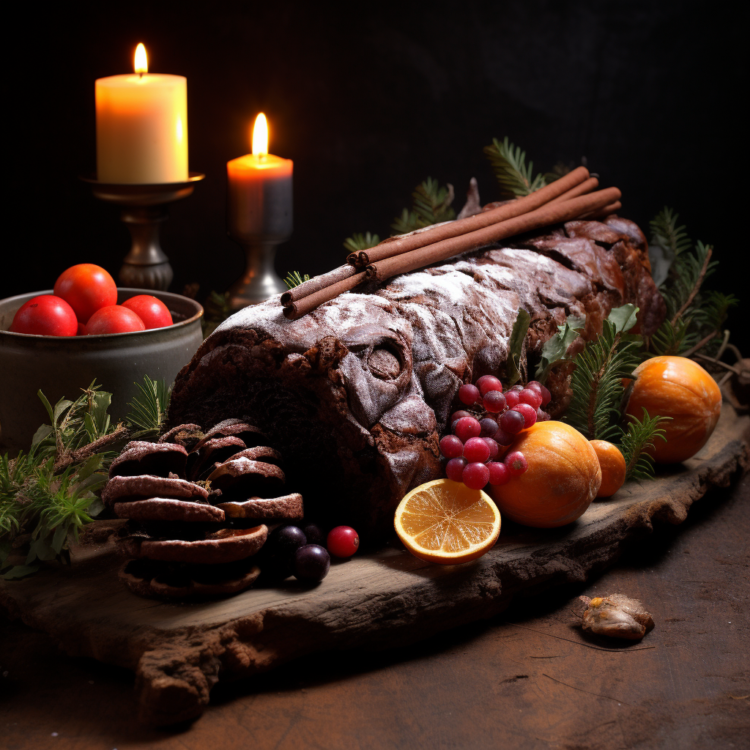
Gift-giving is also a cherished tradition during Yule. Pagans exchange gifts as a way to show gratitude and appreciation for one another. These gifts may be symbolic of renewal, such as seeds or plants, or they can be tokens of love and friendship. The act of giving and receiving gifts reinforces the spirit of generosity and community that Yule embodies.
Feasting and sharing a hearty meal is another integral part of Yule celebrations. The winter solstice is a time when food and sustenance were traditionally scarce, and thus feasting during Yule serves as a celebration of abundance and gratitude. Traditional foods such as roasted meats, root vegetables, and warm spices are enjoyed, filling the air with the comforting aromas of the season.
Evergreens play a significant role in Yule decorations. They symbolize everlasting life and the resilience of nature during the barren winter months. Yule wreaths, garlands, and trees adorned with lights and ornaments are common sights in Pagan households. The use of evergreens not only adds a festive touch but also serves as a reminder of the enduring cycle of life and the promise of spring.
Yule is a time of gathering with loved ones and celebrating the bonds of community. Pagans come together to share in rituals, songs, and stories that celebrate the return of light and the power of unity. It is a time to strengthen connections, foster warmth, and support one another through the cold winter months.
As the Wheel of the Year turns, Yule serves as a reminder that even in the darkest of times, there is always the potential for light and renewal. It is a celebration of hope, rebirth, and the eternal cycle of life. Through rituals, feasting, and joyful gatherings, Pagans embrace the spirit of Yule and carry its warmth and light within them as they navigate the winter season.
Imbolc
Imbolc, celebrated on February 1st, is a significant Pagan holiday that marks the midpoint between the winter solstice and the spring equinox. It is a time of transition, when the harsh grip of winter begins to loosen, and the first signs of spring emerge. Imbolc is associated with the goddess Brigid and carries themes of purification, healing, and the stirrings of new life.
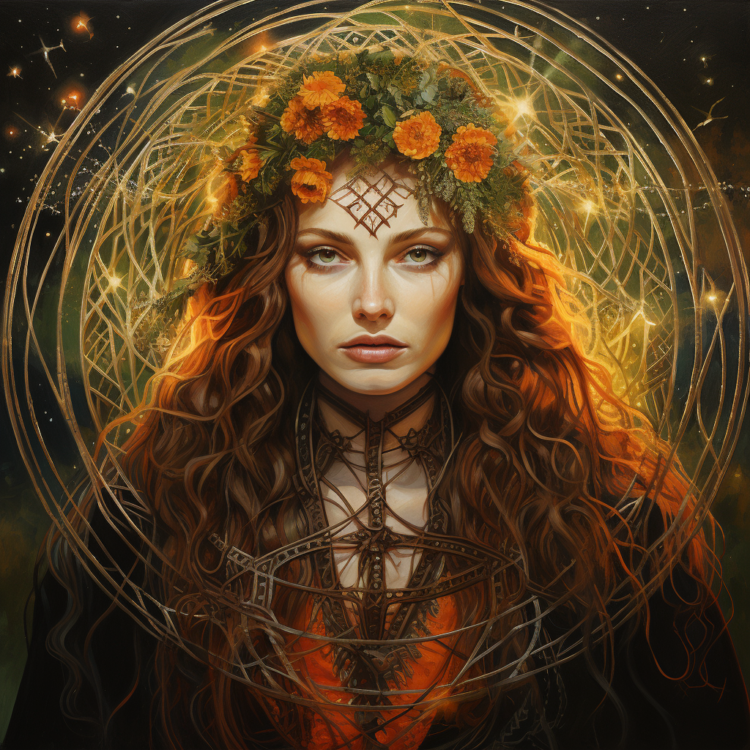
Imbolc heralds the awakening of the Earth from its winter slumber and the return of light and warmth. It is a time when the days become noticeably longer, and nature begins to show signs of rejuvenation. The land may be covered in a blanket of snow, but underneath, the seeds of new growth lie dormant, waiting to burst forth.
One of the central aspects of Imbolc is purification. Pagans engage in rituals and practices to cleanse themselves physically, emotionally, and spiritually. This purification is often symbolized by the element of fire. Candles and bonfires are lit to represent the return of the sun’s radiant energy and to purify the surroundings.
Imbolc is strongly associated with the goddess Brigid, who represents the hearth, home, and healing. Pagans pay homage to Brigid by creating Brigid’s crosses, which are woven from reeds or straw and placed above doorways or hearths as a symbol of protection and to invoke her blessings. Offerings of milk, bread, or other foods are made to honor her and seek her guidance and assistance in matters of healing and inspiration.
As Imbolc is a time of new beginnings, it is customary to perform divination or seek insights into the future. Tarot readings, scrying, and other forms of fortune-telling may be practiced during this time to gain clarity and guidance for the year ahead. This allows individuals to harness the energy of Imbolc to set intentions, make plans, and embark on new ventures.
Imbolc is also closely associated with the agricultural cycle and the preparation for the planting season. It is a time to bless seeds, both literal and metaphorical, and to set intentions for growth and abundance. Some Pagans create “Brigid’s beds,” small areas of soil or containers where seeds are planted and nurtured, symbolizing the potential for new life and the coming of spring.
Feasting is an integral part of Imbolc celebrations. Foods associated with the season, such as dairy products, bread, and early spring herbs, are enjoyed. These foods symbolize the returning abundance of the land and the nourishment it provides.
Imbolc is also a time to honor creativity and inspiration. Pagans engage in artistic pursuits, poetry, and storytelling to celebrate the spark of creativity within themselves and the awakening of the natural world. It is a time to tap into the wellspring of inspiration and express it in various forms.
Community and sharing play a significant role in Imbolc celebrations. Pagans gather in groups or covens to perform rituals, share meals, and support one another in their intentions for the coming year. The collective energy generated during these gatherings amplifies the power of Imbolc and strengthens the bonds of the community.
Imbolc serves as a reminder that, even in the midst of winter’s grasp, the promise of spring and renewal is just around the corner. It is a time to celebrate the return of light, the stirring of life, and the potential for growth. Through purification, honoring Brigid, divination, and creative expression, Pagans embrace the transformative energy of Imbolc and welcome the unfolding of a new cycle.
Ostara
Ostara, celebrated around March 21st, is a Pagan holiday that corresponds with the spring equinox—a moment of perfect balance between day and night. It marks the official arrival of spring, when the Earth awakens from its winter slumber and bursts forth with new life. Ostara is a time of fertility, rebirth, and the celebration of the awakening of nature’s vitality.
One of the central themes of Ostara is the return of light and the lengthening of days. As the sun’s power grows stronger, it provides the energy necessary for the Earth to rejuvenate. Pagans embrace this energy by participating in rituals that honor the rising sun and celebrate the increasing light. Lighting candles, facing the sunrise, or creating symbolic representations of the sun are common practices during Ostara.
Ostara is closely associated with the goddess of the same name, representing fertility, new beginnings, and the cyclical nature of life. Pagans pay homage to Ostara by creating altars adorned with spring flowers, colored eggs, and symbols of renewal. Offerings of seeds, grains, or flowers are made to invoke her blessings and align with the vibrant energy of the season.
Eggs hold special significance during Ostara, symbolizing fertility and the potential for new life. Pagans engage in the tradition of decorating eggs, using vibrant colors and intricate designs. These decorated eggs are often incorporated into rituals and used as offerings or talismans to represent the creative forces of nature and the promise of growth.
The symbolism of hares or rabbits is also prominent during Ostara. These animals are known for their prolific breeding and association with fertility. Images of hares or rabbits are displayed, and some Pagans participate in the tradition of creating or acquiring a “Ostara hare” figurine or symbol to invite abundance and vitality into their lives.
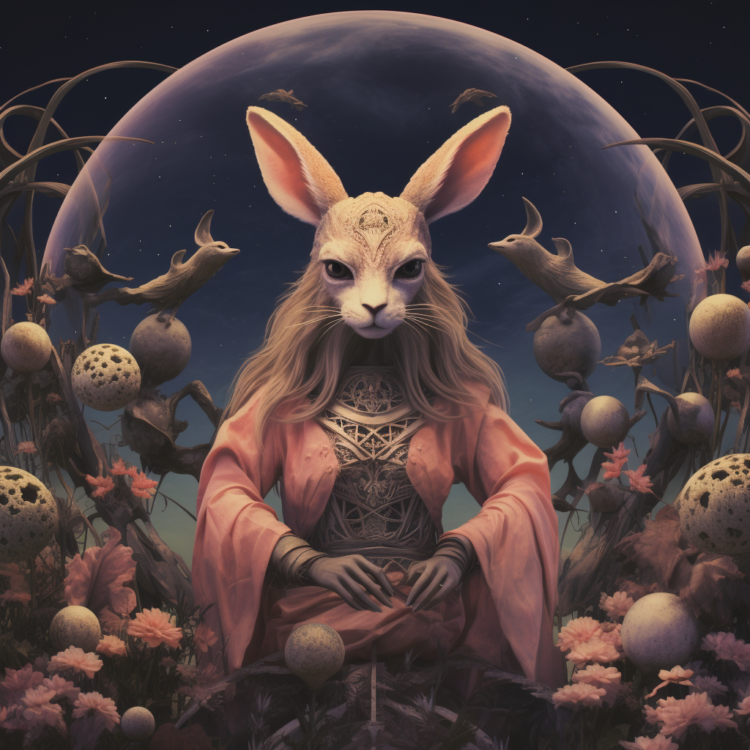
Ostara is a time to honor the Earth and engage in activities that celebrate the greening of the land. Pagans may participate in the planting of seeds or tending to gardens as a way to connect with the life force that permeates the Earth during this season. It is a time of nurturing and cultivating new growth, both in the physical and metaphorical sense.
The practice of spring cleaning is another tradition associated with Ostara. It is a time to declutter, refresh, and purify one’s physical space. Pagans engage in cleaning rituals, clearing away stagnant energy and making room for the renewed energy of the season. This process aligns with the themes of purification and renewal that Ostara embodies.
Feasting is an integral part of Ostara celebrations. Foods associated with the season, such as fresh greens, sprouts, and early spring vegetables, are incorporated into meals. These foods symbolize the abundance and vitality of the Earth’s offerings. Sharing a feast with loved ones is a way to express gratitude for the gifts of nature and foster connections within the community.
Ostara is a time for celebration, joy, and embracing the beauty of the natural world. Pagans come together to perform rituals, engage in music and dance, and celebrate the returning life force. It is a time to shed the heaviness of winter and embrace the promise of new beginnings, growth, and transformation.
By honoring the cycles of nature and aligning with the energy of Ostara, Pagans connect with the inherent vitality and renewal that spring brings. It is a time of embracing the awakening Earth, celebrating fertility and rebirth, and embracing the opportunities for growth and expansion in all aspects of life.
Beltane
Embracing the Arrival of Summer Beltane, celebrated on May 1st, is a vibrant and energetic Pagan holiday that marks the midpoint between the spring equinox and the summer solstice. It is a time of fertility, passion, and the celebration of life in full bloom. Beltane represents the union of the masculine and feminine energies, the merging of the spiritual and physical realms, and the joyous expression of vitality.
One of the central themes of Beltane is the celebration of fertility and the abundance of life. Pagans honor the Earth’s blossoming vitality by adorning themselves and their surroundings with flowers and greenery. Maypoles, tall decorated poles wrapped in ribbons and flowers, are erected and used as a focal point for joyful dances and weaving patterns, symbolizing the union of the masculine and feminine forces.
Beltane is also associated with the Celtic god and goddess, often portrayed as the Green Man and the May Queen. These figures represent the vitality of nature, the power of growth, and the sacred union between humans and the Earth. Pagans pay homage to these deities by creating altars adorned with fresh flowers, green leaves, and symbols of fertility. Offerings of food, drink, or handmade crafts are made to honor their presence and seek their blessings.
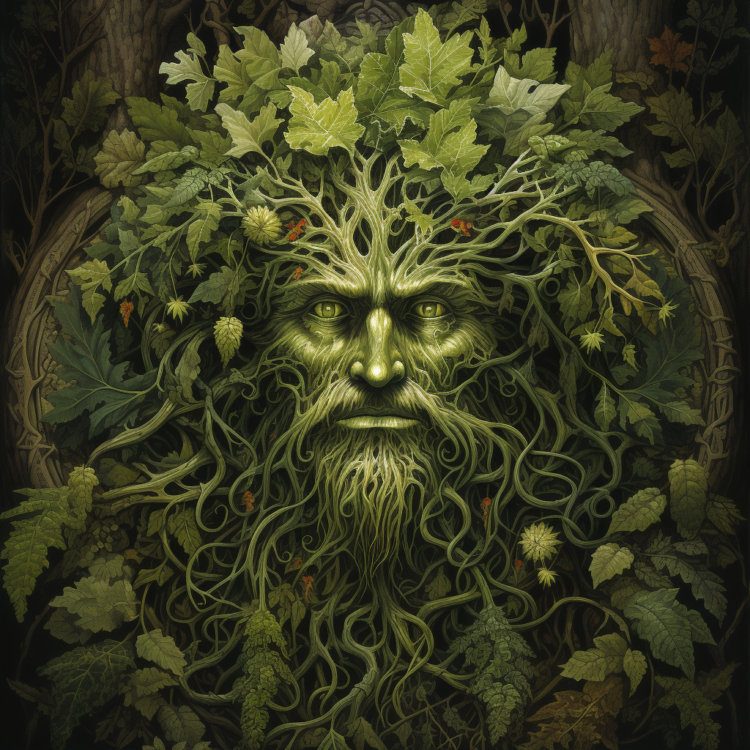
The lighting of bonfires is a significant aspect of Beltane celebrations. The flames represent the transformative power of fire and serve as a focal point for community gatherings. Pagans leap over the fires as a symbol of purification, letting go of the old and embracing new beginnings. The ashes from the bonfires are believed to hold protective and fertile qualities, and they are sometimes scattered over fields or gardens to bless the land.
Beltane is a time of courtship and love, often associated with the joyous expression of sensuality and sexuality. It is believed that the boundaries between the physical and spiritual realms are particularly thin during Beltane, making it an auspicious time for romantic connections and sacred unions. Handfasting ceremonies, a Pagan ritual of joining two individuals in partnership, are common during this time, symbolizing the commitment and bond of love.
May Day, a traditional celebration associated with Beltane, involves dancing around the maypole, crowning a May Queen, and engaging in outdoor festivities. These activities evoke a sense of community, playfulness, and connection with nature. It is a time for music, singing, and merriment, as people come together to celebrate the abundant energy and the awakening of the Earth.
Beltane is also a time for connecting with the natural world and nurturing the Earth’s fertility. Pagans may participate in rituals such as planting seeds or tending to gardens as a way to align with the Earth’s life-giving energy. Offerings of flowers, herbs, or homemade crafts can be left in nature as a gesture of gratitude for the bountiful gifts provided by the Earth.
Feasting is an important part of Beltane celebrations. Foods associated with the season, such as fresh fruits, vegetables, honey, and dairy products, are enjoyed. Sharing a communal meal strengthens the bonds of community and celebrates the abundance and fertility of the Earth’s harvest.
Beltane is a time of joy, celebration, and the unbridled expression of life’s vitality. Pagans come together to dance, sing, and honor the Earth’s abundance. It is a time to embrace the sensuality of existence, celebrate love and partnership, and revel in the flourishing beauty of the natural world. Through rituals, festivities, and the weaving of connections, Beltane serves as a reminder of the sacredness and interconnectedness of all life.
Litha
The Summer Solstice Litha, also known as Midsummer, is one of the significant Pagan holidays celebrated around June 21st. It represents the height of the summer season, when the sun reaches its zenith and the day is at its longest. Litha is a time of abundance, light, and the celebration of the Earth’s vitality.
One of the central themes of Litha is the power of the sun. The sun’s energy is at its peak during this time, providing warmth, light, and nourishment to the Earth. Pagans honor the sun’s life-giving energy by engaging in rituals that celebrate its strength and significance. Meditating or practicing sun salutations during sunrise or sunset are common practices during Litha to connect with the sun’s energy and express gratitude for its blessings.
Litha is associated with fire and bonfires. It is believed that the element of fire reaches its highest potential during this time, symbolizing transformation and the burning away of negativity. Pagans light bonfires and candles to honor the sun’s fiery energy and to create a sacred space for community gatherings and celebrations. Jumping over the flames is a tradition that represents purification and the release of any obstacles or burdens.
The turning point of the year, from the waxing to the waning of the sun, is a significant aspect of Litha. Pagans reflect on the changing seasons and the cycles of life, acknowledging that after reaching its peak, the sun will begin to wane. It is a time to appreciate the abundance and vitality of the summer season while recognizing the fleeting nature of time.
Flower crowns and wreaths are common symbols of Litha. They represent the blooming of nature and the vibrant colors that adorn the Earth during the summer months. Pagans create and wear these floral adornments as a way to connect with the beauty and vitality of the natural world and to honor the fertility and abundance of the Earth.

Litha is also associated with water and the element of the divine feminine. Water represents emotional healing, intuition, and the flow of life. Pagans may engage in rituals near bodies of water, such as rivers or lakes, to connect with the energy of water and honor its life-giving properties. Some may even choose to go swimming or perform water-related ceremonies as a way to cleanse and rejuvenate the spirit.
The gathering of herbs and the making of herbal preparations are traditional activities during Litha. Medicinal and magical herbs are believed to be at their most potent during this time, carrying the essence of the sun’s energy. Pagans may harvest herbs and create herbal remedies, tinctures, or teas to support physical and spiritual well-being. These herbal preparations are often used in rituals or offered as gifts to honor the Earth’s bounty.
Feasting and sharing a bountiful meal are integral parts of Litha celebrations. Foods associated with the season, such as fresh fruits, vegetables, berries, and grains, are enjoyed. Sharing a communal feast is a way to honor the Earth’s abundance and to celebrate the gifts of nature with loved ones.
Litha is a time of celebration, gratitude, and embracing the vibrant energy of the summer season. Pagans come together to honor the sun, connect with the elements, and celebrate the Earth’s vitality. It is a time to appreciate the abundance of nature, to express joy and gratitude for the blessings of life, and to align with the cycles of the sun and the Earth as they dance in harmony.
Lammas/Lughnasadh
Lammas, also known as Lughnasadh, is a significant Pagan holiday celebrated on August 1st. It marks the beginning of the harvest season and is a time to give thanks for the bountiful abundance of the Earth’s gifts. Lammas represents the first harvest, when the grains and fruits of the land ripen and are ready to be gathered.
One of the central themes of Lammas is the celebration of the harvest and the cycle of life and death. Pagans honor the Earth’s abundance by participating in rituals that express gratitude for the harvest and acknowledge the sacrifice of the land. It is a time to recognize the interconnectedness of all life and the sustenance provided by the Earth.
Lammas is associated with the god Lugh, a Celtic deity of light, craftsmanship, and harvest. Pagans pay homage to Lugh by creating altars adorned with grains, fruits, and symbols of abundance. Offerings of freshly baked bread, honey, or other foods are made to honor Lugh and seek his blessings for a plentiful harvest.
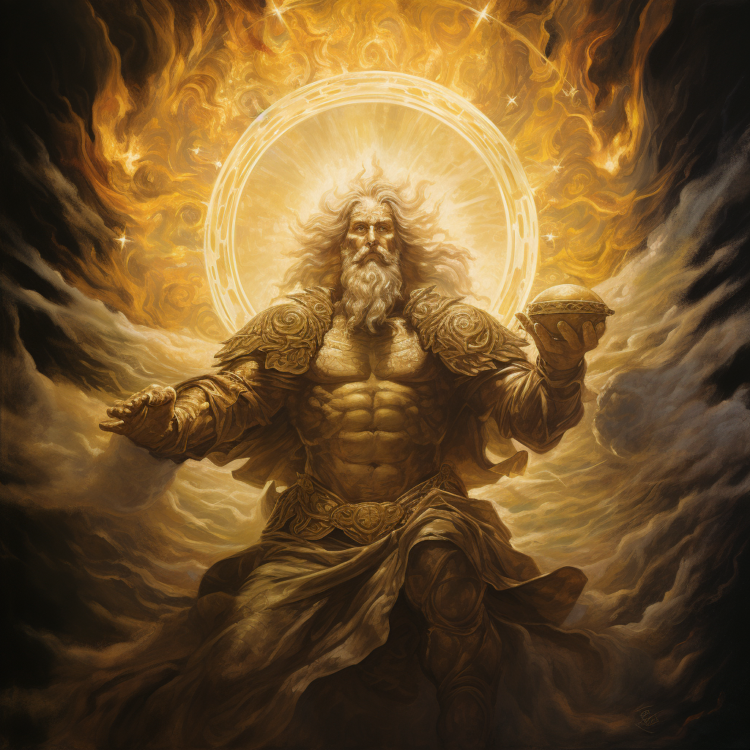
Baking bread is a traditional activity during Lammas. The grain harvest is celebrated by making and sharing loaves of bread made from freshly harvested grains. This act symbolizes the transformation of the Earth’s bounty into nourishment and sustenance for the community. Sharing bread with loved ones and neighbors fosters a sense of unity and gratitude for the interconnectedness of all.
Lammas is a time to reflect on personal growth and the manifestation of goals and intentions. Pagans take stock of the seeds they have sown in their own lives and the progress they have made throughout the year. It is an opportunity to assess achievements, express gratitude, and set new intentions for the coming months.
The weaving of corn dollies is a traditional craft associated with Lammas. Corn dollies are intricate braided or woven figures made from dried corn stalks. They represent the spirit of the grain and are often displayed in homes or hung in fields as a symbol of protection and fertility. Creating corn dollies is a way to connect with the Earth’s abundance and honor the cycle of life and death.
Lammas is a time to connect with the natural world and appreciate the beauty of the land. Pagans may participate in nature walks, hikes, or rituals held in open fields or near bodies of water. Engaging in these activities allows individuals to immerse themselves in the energy of the season and foster a deeper connection with the Earth.
Community gatherings and fairs are common during Lammas. Pagans come together to celebrate the harvest, share meals, and exchange goods and crafts. These events promote a sense of unity and camaraderie, and they offer an opportunity to appreciate the diversity and talents within the community.
Feasting is an integral part of Lammas celebrations. Foods associated with the harvest, such as freshly baked bread, fruits, vegetables, and grains, are enjoyed. Sharing a communal meal is a way to honor the Earth’s bounty and to strengthen the bonds within the community.
Lammas serves as a reminder of the cycles of life, the Earth’s abundance, and the importance of gratitude. Pagans come together to celebrate the harvest, express appreciation for the gifts of the land, and acknowledge the interconnectedness of all life. Through rituals, feasting, and community gatherings, Lammas fosters a sense of unity, gratitude, and reverence for the Earth’s abundant offerings.
Mabon
The Autumn Equinox Mabon, is a Pagan holiday celebrated around September 21st. It marks the second harvest of the year and the arrival of the autumn season. Mabon is a time of balance, reflection, and expressing gratitude for the Earth’s abundance before the onset of the colder months.
One of the central themes of Mabon is the celebration of the harvest and the gathering of the Earth’s bounty. Pagans honor the fruits of their labor by engaging in rituals that express gratitude for the abundance of the land. It is a time to recognize the interplay between light and darkness, as the day and night are equal in length during the autumn equinox.
Mabon is associated with the god Mabon, a Welsh deity of the harvest and the season of autumn. Pagans pay homage to Mabon by creating altars adorned with autumnal colors, seasonal vegetables, and symbols of the harvest. Offerings of fruits, grains, or cider are made to honor Mabon and seek his blessings for a successful and fruitful harvest.
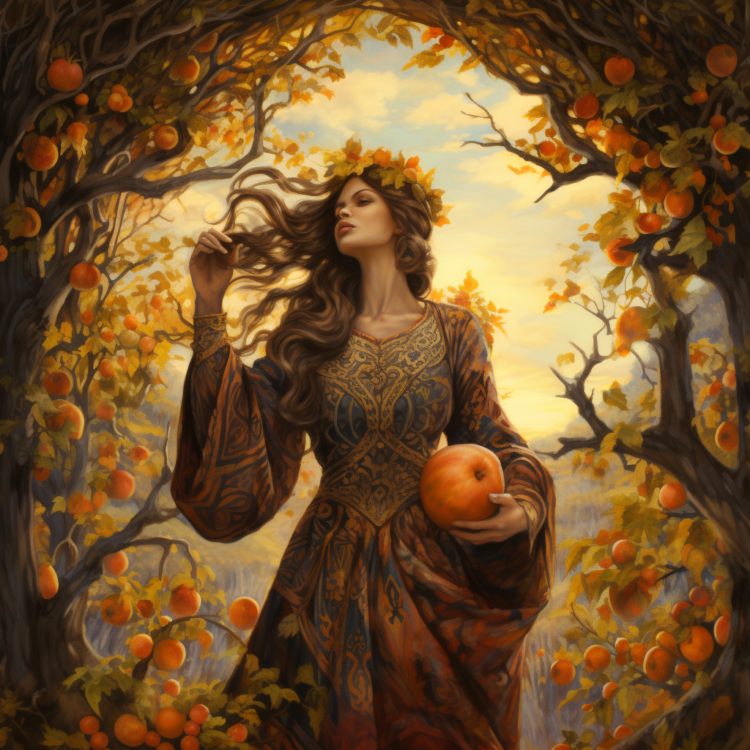
The autumn equinox is a time to reflect on the balance between light and darkness, both externally and within ourselves. Pagans take this opportunity to acknowledge the shifting energies of the season and to find equilibrium in their lives. It is a time to assess the fruits of one’s efforts and to find harmony in the dualities of life.
The gathering of fallen leaves, acorns, or other natural elements is a traditional activity during Mabon. These items are often used to decorate altars or create crafts that symbolize the changing season. By engaging in these activities, Pagans connect with the Earth’s transformation and honor the beauty of the autumnal landscape.
Mabon is a time to prepare for the coming winter months. Pagans may engage in rituals of preservation, such as canning or drying fruits and vegetables, to store the bounty of the harvest. It is also a time to acknowledge the cyclical nature of life and to let go of what is no longer needed, both in the physical and metaphorical sense.
The lighting of candles or lanterns is a common practice during Mabon. These sources of light represent the inner warmth and illumination that guide individuals through the darker months ahead. Pagans may create candle-lit altars or engage in candle rituals as a way to honor the balance of light and darkness during this transitional time.
Mabon is a time to connect with the natural world and appreciate the beauty of the changing season. Pagans may participate in nature walks, forest bathing, or engage in rituals held in natural settings. These activities allow individuals to immerse themselves in the energy of autumn and foster a deeper connection with the Earth.
Feasting is an important part of Mabon celebrations. Foods associated with the harvest, such as root vegetables, apples, squashes, and grains, are enjoyed. Sharing a communal meal is a way to honor the Earth’s bounty, express gratitude, and strengthen the bonds within the community.
Mabon serves as a reminder of the cycles of life, the Earth’s abundance, and the importance of finding balance. Pagans come together to celebrate the harvest, express appreciation for the gifts of the land, and acknowledge the interplay between light and darkness. Through rituals, feasting, and connection with nature, Mabon fosters a sense of harmony, gratitude, and introspection as individuals prepare for the approaching winter season.
Wrap Up To Pagan Holidays 2023 The Wheel of the Year
The Wheel of the Year and its Pagan holidays offer a profound opportunity for individuals to connect with nature, honor ancestral traditions, and find meaning in the cycles of life.
Pagan holidays offer a rich tapestry of traditions, rituals, and celebrations that connect individuals with the cycles of nature, the changing seasons, and the spiritual significance of the Earth’s abundance.
From the Wheel of the Year, which encompasses the various Pagan festivals throughout the year, to the unique customs associated with each holiday, Paganism provides a framework for honoring and revering the natural world.
Through the exploration of the Pagan holidays discussed in this blog post, we have glimpsed the diverse ways in which Pagans connect with the Earth, the divine, and the rhythms of life. From Samhain’s solemn remembrance of ancestors to Yule’s celebration of light amidst darkness, from Imbolc’s symbol of awakening to Beltane’s joyful expression of fertility, from Litha’s honoring of the sun’s power to Lammas’ gratitude for the harvest, and finally to Mabon’s reflection on balance and transition, each holiday brings its own unique energy and significance.
By participating in Pagan celebrations, individuals can cultivate a deep sense of connection with nature and the divine, fostering a profound appreciation for the interconnectedness of all life. These holidays provide an opportunity for reflection, gratitude, community building, and personal growth. They serve as reminders of the sacredness of the natural world, the cycles of life, and the importance of finding harmony within ourselves and our surroundings.
Whether one follows a specific Pagan path or simply appreciates the wisdom and beauty of these traditions, the Pagan holidays offer a meaningful framework for connecting with the Earth, cultivating spiritual awareness, and celebrating the cycles of life. They invite us to slow down, to attune ourselves to nature’s rhythms, and to honor the gifts that the Earth bestows upon us.
As we embrace the richness and diversity of Pagan holidays, may we deepen our reverence for the Earth, nurture our spiritual connections, and cultivate a profound sense of gratitude for the wondrous tapestry of life that surrounds us. May these traditions inspire us to live in harmony with nature, to honor the cycles of life, and to foster a deep sense of interconnectedness and reverence for all beings.
In the embrace of Pagan holidays, may we find guidance, inspiration, and a renewed sense of wonder as we journey through the cycles of the year and celebrate the beauty and magic of the natural world.

